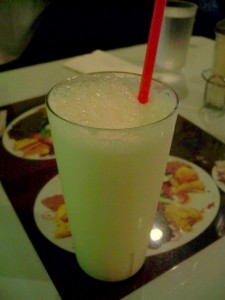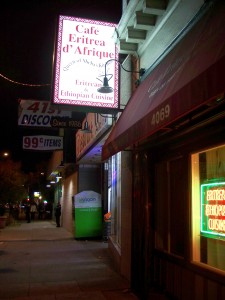
Usually I have no problem remembering restaurant names, both foreign and English. But Eritrea D’Afrique is for some reason a tricky business, I have to search for the receipt to get the name right. And it’s not just the name, its entrance is tricky too. We see the sign, we see people inside, we try what we think to be the door, which is locked. Confused and slightly embarrassed with bypassers, we look through another door to its right and see a bar. It turns out the bar is part of the cafe. Inside, the spacious, curtained and dimly lit dining room has three table occupied, all by Africans who seem quite at home with the place and converse in their own language. Always a good sign.
I notice them using their hands to scoop up food, just like the Indians, and a thought of worry comes. Sure, we eat pizza, spring rolls, goi cuon, fruits, bread, fried chicken, ribs, and a gazillion other things with hands, but it’s dubious how much bean and salad I can gather with the tip of my fingers. It’s the efficiency, not the messiness, that makes me consider a fork, which turns out to be unnecessary. Because unlike the Indians, the Eritreans use more than just fingers to scoop. In fact, their injera should win the prize for the most efficient utensil out there.

First of all, it’s thin, resilient, and easy to handle. You tear a piece, you scoop, you wipe the plate. Secondly, its porous side grasps, soaks, and holds soft food like no other. And finally, it’s edible. How many utensils in the world can be stuffed in the mouth and digested in the stomach? It’s airy, spongy, it’s a little sour, it’s a snack by itself and a flavorful addition to other foods. It’s brilliant.

Not to mention it’s also a serving plate. Topped with our seven-coursed veggie samplers and a heap of stir fried beef. The veggies remind me of Istanbul Grill‘s appetizer collection: there’s humus, cabbage and green beans, hamlee (collard greens), shiro (chick pea puree), birsin (split lentil stew), potatoes, and salad in the middle. The shiro and birzin are expectedly similar, both with a natural subtle sweetness of legumes, but birsin resembles creamed corn while shiro is closed to Mexican refried bean. I’m not crazy for humus, the hamlee can go, but I wish they gave us more of that mushy, saucy, savory cabbage.

I wouldn’t mind a total vegan Eritrean meal, since the veggie flavorings are not too different from the meat flavorings. The texture contrast, however, is a nice change, going from mushy cabbage and beans to charred, hardened, cubed beef. Mild kulwa, beef stir fried in spiced butter, garlic, onion, and pepper, does not sound like something that can easily go wrong, and it doesn’t. In some way, it’s just a smaller, sharper, tangier version of the Vietnamese bo luc lac. In the end, my Asian palate prefers some sweetness in the savories, so the frothy orange cream with ever-so-subtle orange juice and honey is a heavenly nectar. Even the sound of them squeezing and frothing it in the kitchen is music to my ears.

Prior to today I’d known of Ethiopia but not Eritrea. The geographical proximity of the two countries must imply cuisine similarities, but how similar? Is it like Lao and Thai? Or is it more like Korean and Japanese? Considering Oakland has a whole street of Ethiopian restaurants (while the whole East Bay has only one address for Indonesian food), I felt both excited and obligated to try Ethiopian for the first time, but perhaps this is more like my halfth time?
Address: Cafe Eritrea D’Afrique (North Oakland)
4069 Telegraph Ave
(between 40th St & 41st St)
Oakland, CA 94609
(510) 547-4520



Leave a Reply